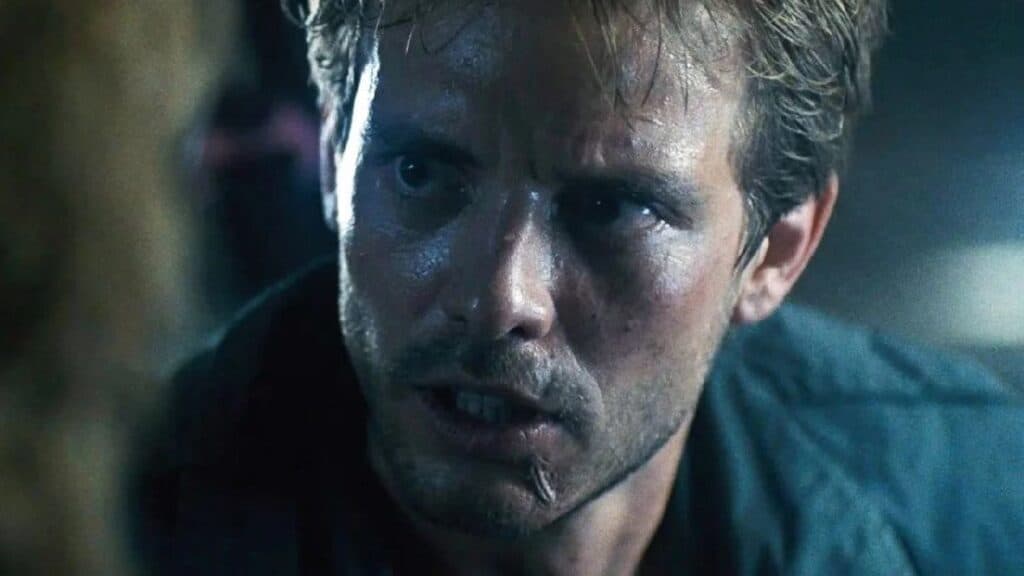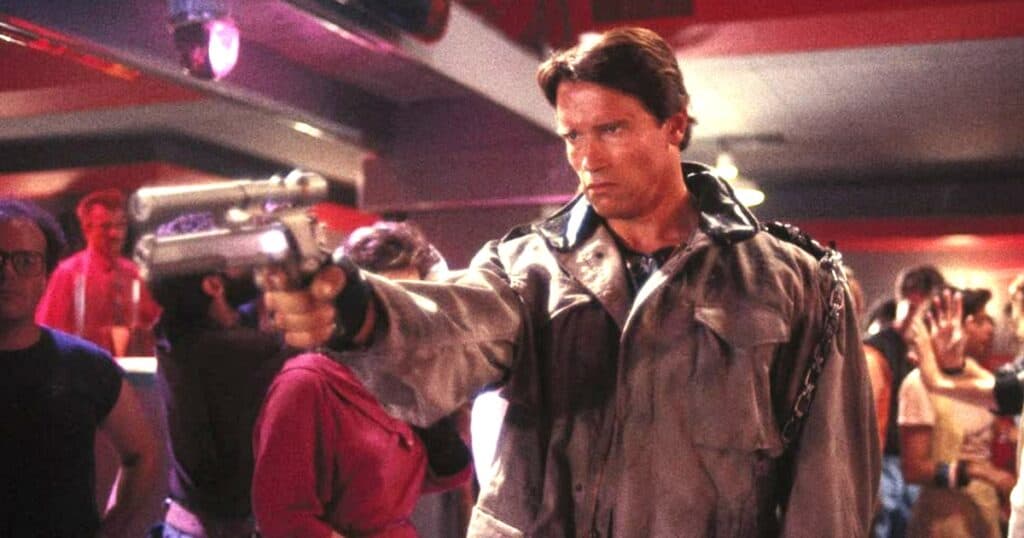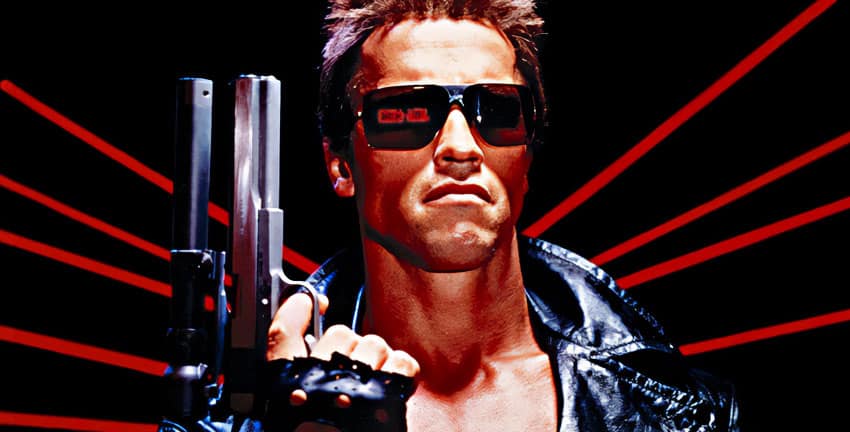INTRO: There’s one line that will forever go down in movie history as one of the most iconic moments of dialogue ever, and it was almost never to be. While filming the 1984 sci-fi / action / horror classic The Terminator, director James Cameron had initially written the line for Arnold Schwarzenegger as “I’ll come back”. However, as seen in the recent Netflix documentary series on the Austrian Oak, Arnie and Cameron had a heated clash over the line. Schwarzenegger hadn’t said the line correctly so Cameron suggested he just say the now iconic “I’ll be back” instead, leading Arnie to questioning the director’s writing, and getting a suitably pissed-off response in return.
This is just one example of how The Terminator not only became one of the most beloved movie franchises in Hollywood history, well, it is if you stop at part two that is, but that’s a story for later. It also launched the career of an actor who, up until its release, had been an enormously successful bodybuilder, with roles in smaller features, plus an awesome turn as Conan the Barbarian in the John Miluis epic from 1982. So, get yourselves glammed up for a night at Tech Noir as we head out to party with The Terminator here on ARNIE REVISITED!
SET-UP: The year 1984 is much beloved by movie fans for many reasons. It gave us snarky cops with an attitude, horror icons with inventive weapons, adorable fluffy pets who multiply in water, and worse still become malevolent little bastards when fed after midnight, plus countless other movie gems. The eighties is an era much mimicked and drawn upon for not just film studios to suck the blood out of franchises wherever possible, but also to look back upon with fresh eyes once in a while. And, eyes don’t come more fresh than one that’s just been pulled from the skull of a T-800 in a motel bathroom. By the way, how great does the VFX look in that scene still? Yeah, it’s dated but shit like that is what makes movies feel ‘alive’ and also come to life. I’d take a rubber-looking Arnie head, or even a stop-motion ED-209, over a de-aged Indiana Jones any day of the week. But hey, that’s the future kids!

The initial concept for The Terminator came from a somewhat unusual incident. Director James Cameron had fallen ill and during what must have been one hell of a messed up fever-dream, he envisioned a metallic torso holding kitchen knives dragging itself from an explosion. We’ve all been there, right? This, along with his inspiration from John Carpenter’s ‘Halloween’ was the launching pad for Cameron to write the movie we now all know and adore. As well as the seminal Halloween from 1978, Cameron also drew inspiration from the 1960s fantasy TV series The Outer Limits, plus Walter Hill’s The Driver and the post-apocalyptic dystopian classic, The Road Warrior. The initial concept of the script had two Terminators being sent to the past to kill the unfortunate but ultimate badass Sarah Connor, plus all other Sarah Connors in the area, of course. However, Cameron didn’t think he could successfully visualize the second Terminator, which was to be made of liquid metal and was more or less indestructible.
With almost everything in place for the project to be greenlit, all Cameron needed was to secure sufficient financial backing that would see his ambitious vision come to robotic life. And, in what was probably a slightly desperate and uncharacteristic move, Cameron sold the rights for The Terminator to producer Gale Anne Hurd for the measly sum of one whole American dollar. That’s right, just a solitary dollar, with the all important caveat being that Cameron would be guaranteed to direct it. After some negotiations, Orion Pictures agreed to distribute the movie, if Cameron could source financial backing elsewhere. Chairman and President of Hemdale Film Corporation, John Daly, picked up the script and became executive producers on the project. Cameron still needed to pitch his film to Daly and his partners and in an amusing anecdote he enlisted his friend and future Aliens robot ‘Bishop’, Lance Henrikson, to help out. The actor donned the full Terminator costume, leather jacket, scars on his face, gold foil on his teeth – the whole works, and burst through the office door before sitting menacingly in a chair. The act worked and Daly agreed to help finance the film, with backing from HBO and Orion.
Not only was the casting of Arnold Schwarzenegger as the relentless cyborg in The Terminator inspired, it was also somewhat fortuitous and also the first time an
Initially reluctant Schwarzenegger would play a villain. The studios first choice for the role of the Terminator was former NFL star O.J Simpson, however the movie’s producers weren’t convinced, stating that they couldn’t see Simpson as quote-unquote “a killing machine”. Mike Medavow, the co-founder of Orion Pictures had whittled down the cast to have O.J. Simspon playing the Terminator and Arnie as resistance fighter Kyle Reese. It wasn’t until director James Cameron sat down to meet with Schwarzenegger that he started to realise that not only did Simpson and the Austrian Oak not go together at all, but that Arnie may actually be the better fit for the relentless cyborg. Pus, it also transpired that nobody at Orion pictures were now convinced that O.J. Simpson was the right fit for the character.
Since the movie’s release, Cameron has gone on record to reveal the process behind the ultimate decision to cast Arnie in the role, saying that, “casting Arnold Schwarzenegger as our Terminator shouldn’t have worked. The guy is supposed to be an infiltration unit, and there’s no way you wouldn’t spot a Terminator in a crowd instantly if they all looked like Arnold. It made no sense whatsoever. But the beauty of movies is that they don’t have to be logical. They just have to have plausibility. If there’s a visceral, cinematic thing happening that the audience likes, they don’t care if it goes against what’s likely.” Looking back on the movie and, of course, you can’t imagine anybody else playing the Terminator, especially O.J Simpson, or even Sylvester Stallone or Mel Gibson, who also allegedly turned down the role. Arnie took some convincing by Cameron to take on the role but after some lengthy conversations, the actor started to see that the role was the perfect vehicle to further launch his career into the stratosphere.

Alongside Arnie in the movie is a cast whose talents elevate the high concept film almost as much as Schwarzenegger does. For the role of Kyle Reese, who travels back in time to thwart the Terminator’s plan to bump off poor Sarah Connor, the studio met with an eclectic mix of talent. One intriguing example who was in the frame to play Reese was singer, and fellow Geordie, Sting, who met with James Cameron to discuss the part. However, despite the two getting together, Sting felt that Cameron was too unknown as a director at the time and withdrew his interest in the role. Also in the running to play the time-travelling hero were the likes of Matt Dillon, Christopher Reeve, Tommy Lee J ones, Kurt Russel, Scott Glenn and…Bruce Springsteen. However, there was one actor that Cameron had his heart set on but who was initially reluctant – Michael Biehn. The actor had aspirations to work with the likes of Al Pacino and Robert De Niro on more dramatic, serious movies and felt that The Terminator’s concept was perhaps beneath him at this point of his career. However, after meeting with Cameron, Biehn soon changed his mind and the casting in the end was inspired. Most of the actors who came in to audition for the role of Kyle Reese were hard as nails, yet Biehn brought just the correct level of warmth and toughness required.
At the beginning of the script, Sarah Connor is described as, “19, small and delicate features. Pretty in a flawed, accessible way. She doesn’t stop the party when she walks in, but you’d like to get to know her. Her vulnerable quality masks a strength even she doesn’t know exists.” Lisa Langlois had initially been cast to play Connor but had to turn it down ultimately as she was already filming The Slugger’s Wife. Tough break, Lisa! The production then considered Melissa Sue Anderson, Jennifer Jason Leigh, Jessica Harper, Rosanna Arquette and Lea Thompson for the role, before Cameron eventually cast Linda Hamilton as Sarah Connor. Fresh from filming Children of the Corn, Hamilton joined the project with just the right amount of naive vulnerability for the part that would ultimately see the character go from meek waitress to badass heroine over the course of the first two movies at least. Joining Arnie, Biehn and Connor as part of the principal cast members was Cameron’s buddy Lance Henrikson, playing a member of the LAPD, as a way of saying thanks for Henrikson’s part in gaining funding for the movie. Also definitely worth mentioning is the great Bill Paxton who shows up in a small role at the beginning of the movie as one of the punks Arnie’s Terminator terminates. Sporting a killer face tattoo and blue spiky hair before being launched into a metal railing.
REVIEW: Rewatching The Terminator for this retrospective, what really stands out is just how much of a slasher the movie really is. Sure, I’ve seen the movie multiple times over the years and this aspect of the movie isn’t a sudden revelation of course, but it’s fascinating to look at the horror tropes on display. Sarah Connor as the final girl, Arnie’s Terminator evoking the same kind of menace as Michael Myers in the late seventies, a hulking brute hellbent on completing his mission by wiping out numerous members of Los Angeles on the way. This is just an example of how The Terminator easily fits into the horror genre, in my opinion, especially with the ‘unmasking’ of the villain towards the end of the movie. It’s also perhaps why, after the hugely successful Terminator 2, the franchise has faltered in terms of quality. The blue-print for the first movie works perfectly and if the studio had been brave enough to not mess with it too much, the later instalments could have been much stronger.

The movie’s plot follows a cyborg assassin known as a Terminator, disguised as a human, who travels from 2029 to 1984 to kill Hamilton’s Sarah Connor. Sent to protect Sarah is Biehn’s Kyle Reese, who divulges the coming of Skynet, an artificial intelligence system that will spark a nuclear holocaust. Obviously the cops don’t buy his seemingly deranged rants about the future war, cyborgs etc until they’re all dispatched brutally. Sarah is targeted because Skynet knows that her unborn son will lead the fight against them. With the virtually unstoppable Terminator in hot pursuit, Saran and Kyle attempt to escape but find that stopping the relentless machine is almost impossible. Of course, the most exciting, and impressive, element of the movie, even today, is Arnie’s T-800. The actor’s bulging frame and physicality elevates the movie from a great concept to a blisteringly exciting experience. Naturally, you can’t imagine the movie without Arnie, which is why he’s been rolled out for the later, vastly inferior instalments, T2 aside. Surely there’s another kickass Terminator movie left in the franchise? Let us know your thoughts in the comments section, is it dead in the water now, or can it be resurrected?
Alongside the impressive cast overall, the movie also features some excellent VFX that were groundbreaking, if difficult to realise, at the time. Sure, if you’re being overly critical you could comment on how fake Arnie’s face is when his damaged T-800 repairs itself in the motel room, removing its damaged eyeball and also cutting open its arm to patch it up. However, this was practical VFX at their best for the 1980s and whatever your view is of modern CGI, the VFX in The Terminator at least looked like they belonged and were a real aspect of the scene. There’s also an awesome Harryhausen-esque quality to the Terminator at the end of the movie, as its damaged and exposed endoskeleton pursues Connor and Reese through the factory. The image of the T-800s skull attached to one of its dismembered arms is classic 80s action, and horror, at its finest.
The use of stop-motion in the movie’s visual effects was particularly effective and although the technique had been used several times in movies before The Terminator, its use by Industrial Light and Magic in the film is perfect. Just like the awesome skeleton fight scene in Jason and the Argonauts, the moment when the T-800 rises from the fire is a classic cinematic image. It’s not just the VFX that elevates the movie of course. Cameron’s direction, the script, narrative, cast and overall verve on display is amazing and the fact that so many of the franchise’s subsequent movies have been disappointing is a huge shame.
LEGACY / NOW: Despite Orion Pictures having little faith in the movie’s box-office chances, it actually performed above their initially low expectations. Opening in 1,005 theatres in the US on October 26th, 1984, it grossed $4.0 million dollars in its opening week, positioning it at number one at the box-office. It had competition from Universal’s R-rated Terror in the Aisles as well as Brian De Palma’s Body Double before losing its grip on the top spot to the American comedy Oh God, You Devil in week three. The Terminator eventually grossed $38.3 million in the US and $78.3 million worldwide with director James Cameron stating that the box-office return was, “relative to its market, which is between the summer and the Christmas blockbusters. But it’s better to be a big fish in a small pond than the other way around.”
With the movie’s box-office proving to be favourable for both director and studio, the critical reaction was initially slightly mixed. The Los Angeles Times praised the film, calling it, “a crackling thriller full of all sorts of gory treats, loaded with fuel-injected chase scenes, clever special effects and sly humour.” Cinefantastique were also full of praise for Cameron’s epic, stating that it, “manages to be both derivative and original at the same time. Not since The Road Warrior has the genre exhibited so much exuberant carnage. It’s an example of science fiction/horror at its best. Cameron’s no-nonsense approach will make him a sought-after commodity”. Not so sure of the movie’s violence were The New York Times who said that the film was a, “B-movie with flair. Much of it has suspense and personality, and only the obligatory mayhem becomes dull. There is far too much of the latter, in the form of car chases, messy shootouts and Mr. Schwarzenegger slamming brutally into anything that gets in his way.” Ultimately, the movie is regarded as a classic of the genres it does such a good job of inhabiting, whether that’s sci-fi, or as we discussed earlier, a slasher.
However, what’s YOUR take on the movie? Did Cameron manage to achieve his goal of mixing cutting edge technology with a strong, original script that still holds up well today, or are there elements of the movie that should be transported back, sans clothes, to the early eighties? Next up is a deep dive into Cameron’s much anticipated sequel, Terminator 2: Judgement Day, in which we eventually get to see the liquid metal T-1000, slightly jarring child actors, plus a killer soundtrack. Thanks for watching our show and stay tuned for more Arnie-action. We’ll see you next time!

